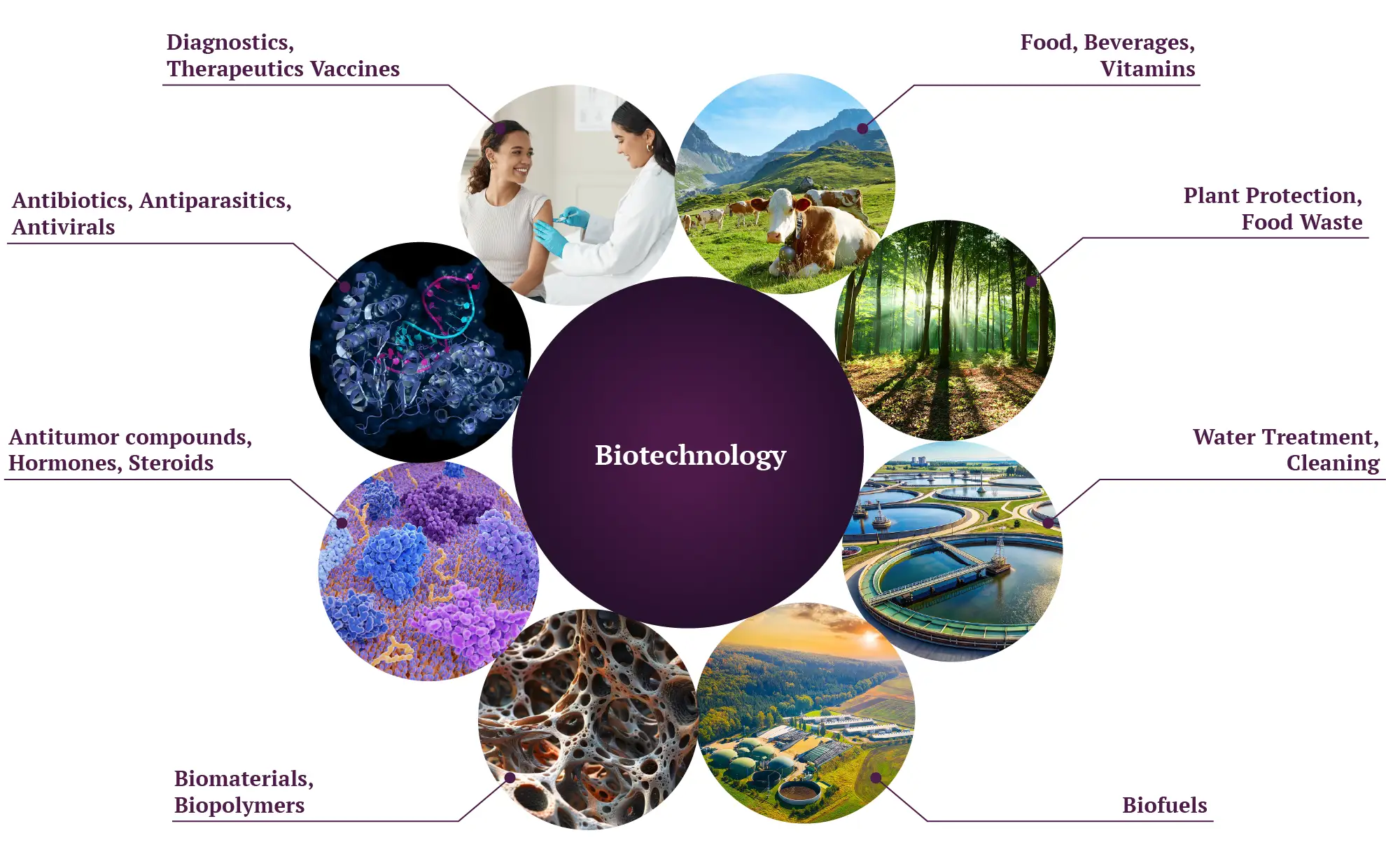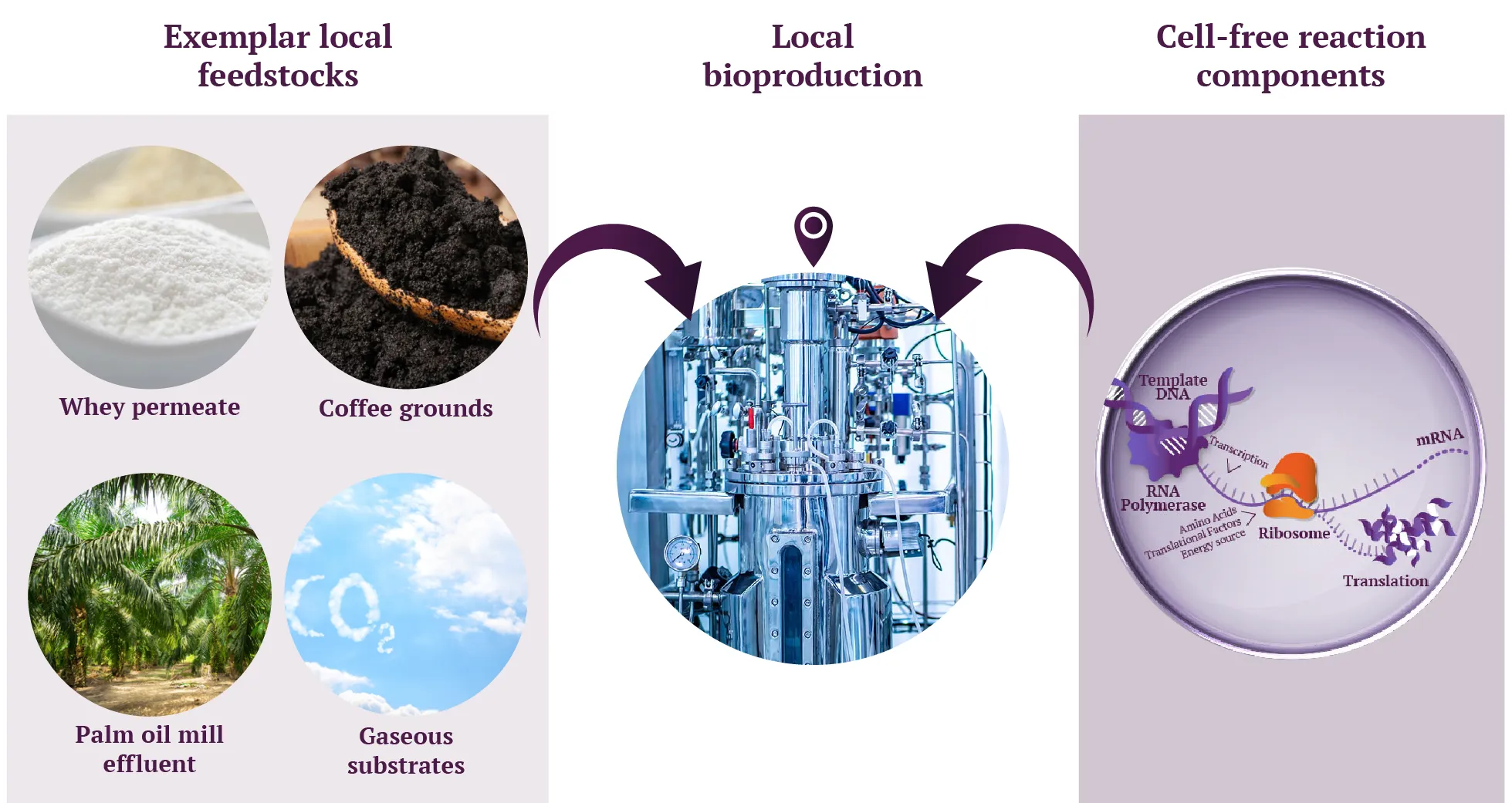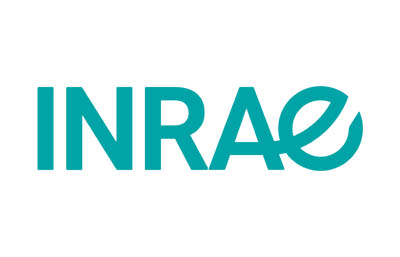The future
of economy
is bio.
Cell-Free fields of application
Bioeconomy leverages knowledge in biology and renewable biomass to meet major contemporary challenges: reducing our dependence on fossil fuels, fighting climate change, food security, and producing new innovative pharmaceutical molecules. Therefore, bioeconomy encompasses all activities involved in the production and transformation of biomass, which can be of agricultural, forestry, marine or bio-waste origin, to produce bioenergy, food, bio-sourced materials and biomolecules. Bioeconomy is guided by principles of sustainable development and environmental sustainability, and its ultimate goal is to allow economic and social development, respecting the natural limits of terrestrial and marine ecosystems.
Applications
Bioenergies are a key part of the bioeconomy with Superethanol, for example, which contains between 65 and 85% of bioethanol produced from beets or cereals, the production of gas and electricity by the methanization of biowaste (food or agricultural in particular), or simply the use of wood energy for heating.
Although there are more than 6,000 species of plants cultivated for food purposes in the world, two thirds of our current food production originate from only 9 crops. Increasing crop diversity is therefore a key part of ensuring food security and a major part of the bioeconomy. This increase in crop diversity will lead to nutritional advantages nutritional intake and better resistance to climatic dangers such as insects, pests and pathogens. Moreover, the use of composts from biowaste enables increased agricultural yields while replacing chemical fertilizers.
The production of bio-based materials is important to a large number of sectors, including :
. construction with the use of plant fibres such as hemp or textile waste for insulation,
. packaging with the use of an enzyme capable of biologically depolymerizing PET-type plastic waste to produce new bottles,
. linen and hemp clothing,
. toys made of wood or bioplastic produced from corn,
. automotive component such as dashboards or door panels made of thermoplastic-based plant fibres etc.
And finally, among such biomolecules we find:
. cosmetic products containing natural oils, algae, minerals,
. detergents and vegetable-derived paints in particular, resins,
. pharmaceutical products synthesized with micro-organisms.
The green economy is leading us towards improvements in human welfare and social equity as well as reducing environmental risks and helping manage ever-diminishing resources.
How it works?
Bioeconomy involves the use of biotechnology to develop innovative processes for the manufacture of a diversity of products, including biopharmaceuticals, vaccines, new plant and animal variants and industrial enzymes (Figure 1). Furthermore, bioeconomy requires the availability of renewable biomass and efficient bioprocesses for a sustainable production. Renewable biomass can be obtained through diverse primary sources (e.g. herbs, trees, algae and food cultures) and domestic, industrial and agricultural wastes (e.g. vegetable peels, sawdust, used vegetable oils, bagasse and cereal straw).
From these materials, bioprocesses enable to produce a panoply of products such as paper, biofuels, plastics and industrial chemical products.
Figure 1 – Biotechnology is a key enabling technology in all bioeconomy networks (health, nutrition, materials, energy and environment). Reproduced from [1].

Challenges and trends
The Food and Agriculture Organization of the United Nations included bioeconomy in its most recent science strategy, and national bioeconomy strategies are being implemented, in line with the United Nations Sustainable Development Goals.
Several challenges persist, such as uncertainties of economics, social and environmental benefits of the emerging bioeconomy and biomass supply systems [2], and industry is calling for the development of innovative biomass technologies and ways to scale up production [3]. Furthermore, investment in the bioeconomy sector must consider sustainability, as bio-based value chains are not inherently sustainable. Moreover, it is important to enable market acceptance and consumer education on bio-based products by facilitating knowledge transfer and technology dissemination between academia, industry and policymakers [4].
The trends in bioeconomy include:
. technological development, either in ground-breaking new technologies or adapting existing technologies to suit local conditions, facilitating the rise of a bio-based industry and manufacturing, and,
. integration of artificial intelligence with bioeconomy-related research, allowing the creation of innovative forms of bioengineering and biomanufacturing, particularly focused to advance the health sector by developing personalized medicine, disease diagnostics and drug discovery [5].
Cell-free systems and bioeconomy
Several cell-free approaches have been developed for the bioproduction of fine chemicals, biofuels and biological materials, according to the principles of bioeconomy. Cell-free systems enable refactoring and optimizing fine chemical or natural product biosynthesis but also de novo bioproduction of biological materials including biopolymers, cellulosic materials and nanoparticles [6].
Local feedstocks can potentially be utilized as replacements for expensive reaction energy mix components, or to provide the enzymatic co-factors and biosynthetic pathway substrates that are required to produce biological materials of interest. This way, cell-free mediated biomanufacturing of biological materials can be performed in a local, sustainable and on-demand basis (Figure 2) [6].
For example, cell-free lactic acid production from spent coffee grounds has been proposed and could become a generalized strategy for sustainable cell-free materials bioproduction [7]. Whey permeate, an industrial waste that has been previously used to optimize in vivo polyhydroxyalkanoates (PHAs) bioplastics production, has also been utilized to develop a cell extract-based production of PHAs [8]. The inclusion of an optimal concentration of whey permeate enhanced the cell-free production by approximately 50%, making the cell-free system a more economically viable approach than the in vivo method.
Figure 2 – Sustainable cell-free biomanufacturing of biological materials. Reproduced from [6].

Publications
References
To know more

United Nation
Five reasons for a substainable and circular global bioeconomy (FAO)

MéthaFrance
Understanding how methanization works

Ministry of Agriculture
What is the bioeconomy?

INRAE
Development of a new enzyme to recycle PET plastic waste into new bottles

Economic Studies Report (pdf)
Inventory of available biobased products
We look
forward to
your questions
Even
a proteine
needs
to express
its potential.
Cell-Free Systems Applications
